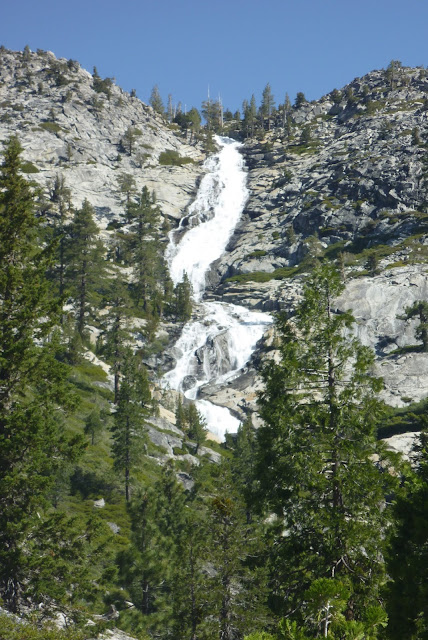 |
| Trestle top entrance for ore cars (and now visitors) into Kentucky Mine stamp mill |

The
Kentucky Mine Museum and Historic Park opened over the Memorial Day Weekend to kick off its 2018 season. I joined the Sunday morning hour-plus tour to see the inside of the
stamp mill. The staircase walk down inside the stamp mill is the highlight, but during the tour one also gets access to the
Kentucky Portal and a replica of a
miners cabin. I really enjoyed to hear the local mining history as told by the tour guide, who also demonstrated how the displayed tools—mining as well as household tools—were used during the
gold-mining days.
 |
| Kentucky Portal and replica of a miners cabin |
Display sites of mining equipment and buildings are connected by
paved trails or
gravel paths. Next to the beginning of the
trestle railway is a bench inviting you to rest awhile in memory of
David Eugene Smith (1948-2013), a gold miner and storyteller. From there, you will have an excellent view of the Kentucky Portal, the miners cabin and an
old trommel in the middle of the “plaza” between cabin and stamp mill.
 |
| Trommel with miners cabin in background |
Our tour guide and her daughter performed snake-checks before letting us enter the portal in front of the adit and the multiple-floor stamp mill. Inside the portal, we got to see an operating
pelton wheel. I was surprise how fast it was spinning and got sprinkled with water while coming close to it. The
adit is connected with the upper floor of the stamp mill by rail, on which
ore cars where transporting ore over the
trestle into the
hopper room above the
grizzley to dump the rocks. From there, the
downfall and
downbreak of the rocks of various sizes into smaller pieces began. They were passing the
jaw crusher and ending up at the bottom, where the pieces were finally powderized under stamps. Two five-stamp settings are there to do the job. We walked down the stairs, floor by floor, to explore the technical details including the well-preserved
belt system,
bull wheels and the
cams and eccentrics that raised and dropped the stamps. The
stamp system still works and was demonstrated to us by manually pulling the associated pelton wheel. The stamp mill operated during times, when mercury was still in use here to separate the gold from milled ore.
Next to the stamp tables, on which gold was separated from the crushed quartz and rocks by amalgamation (alloying), is an exit door. Before leaving the stamp mill, I looked up one more time, to spot some of the
Townsend's big-eared bats roosting in corners high above wheels and belts.
Asking final questions, members of the tour group exited the mill. Now, everyone was on his or her own again to check for snakes. Visitors not encountering a snake on the grounds may be interested in seeing the rattlesnake decorating a
clampers antique hat on display in the museum.
 |
| Sign on Highway 49 for Kentucky Mine Historic Park |
Museum
The
small, awe-inspiring museum is part of the
Bigelow House, a replica of a 19th century hotel.
Location
Find the
park & museum at the end of
Kentucky Mine Road, a short incline off the
Golden Chain Highway (Hwy 49) between
Bassetts Station and downtown
Sierra City:
100 Kentucky Mine Road
Sierra City, CA 96125
$1 museum admission and $7 tour fee for adults (free for children 6 and under, $3.50 for children ages 7-17).
 |
| Kentucky Mine Stamp Mill with trestle |
References and more to explore
[1]
Kentucky Mine Historic Park & Museum.
National Geographic - Sierra Nevada Geotourism. Link:
www.sierranevadageotourism.org/content/kentucky-mine-historic-park-amp-museum/sie9339b2a13f3daefe1.
[2]
Kentucky Mine and Museum.
Backcountry Explorers. Link:
www.backcountryexplorers.com/kentucky-mine-museum.html.


 Recently, I noticed the trail-map entry “Thorton Point Loop 4.0 mi” in the Evans Canyon Trailhead map displayed at the kiosk in the Reno Softball Complex/Disc Golf Course parking area. Older maps just show(ed) Thorton Point (if at all). Anyway, walk from the trailhead to the Basque Sheepherder Monument and you will see the “N” slope with the Thorton Point rock outcrops crowning the Nevada “N” site. From the monument, hike downhill to Evans Canyon grove where a Nature Trail circles through the tiny forest alongside creek banks. Cross Evans Creek and go upward on Miners Canyon Trail/ “N” Trail leading to the “N” site. Before getting to the letter baseline, turn right at the intersection you can see in the upper section of the picture below.
Recently, I noticed the trail-map entry “Thorton Point Loop 4.0 mi” in the Evans Canyon Trailhead map displayed at the kiosk in the Reno Softball Complex/Disc Golf Course parking area. Older maps just show(ed) Thorton Point (if at all). Anyway, walk from the trailhead to the Basque Sheepherder Monument and you will see the “N” slope with the Thorton Point rock outcrops crowning the Nevada “N” site. From the monument, hike downhill to Evans Canyon grove where a Nature Trail circles through the tiny forest alongside creek banks. Cross Evans Creek and go upward on Miners Canyon Trail/ “N” Trail leading to the “N” site. Before getting to the letter baseline, turn right at the intersection you can see in the upper section of the picture below.





























































